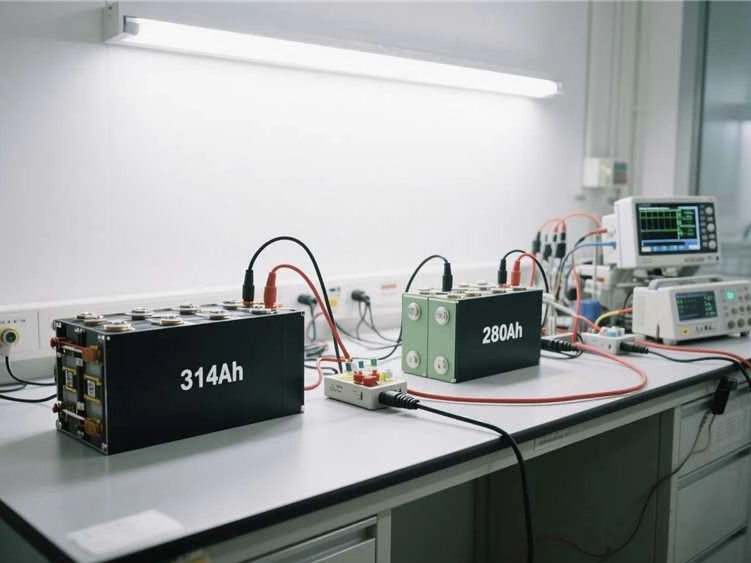What Is the Difference Between 314Ah and 280Ah Battery Cells?

Why Compare 314Ah and 280Ah Battery Cells?
With the maturity of the energy storage industry, lithium battery technology also evolves. Of course, the most sought-after high-capacity batteries are the 280Ah and that very new 314Ah that has started appearing in markets. When choosing between 314Ah and 280Ah batteries, capacity is one parameter and several other factors such as energy density, life, cost-effectiveness, and compatibility would be equally important considerations.
Our article profers alternative solutions with regard to the application and technology differences between the 314Ah and 280Ah kinds of batteries so you may be able to decide which would better serve your energy storage applications.
Introduction to 280Ah and 314Ah Batteries
Before we go into detail, let's observe the two batteries:
280Ah battery: It is an established and popular lithium iron phosphate (LFP) battery used perhaps more than any other in commercial, residential, and utility-scale energy-storage systems. The issue of mature technology and cost-effectiveness has made it popular.
314Ah battery: The step up LFP battery-more capacity in the same size as the 280Ah battery, safer in operation, longer lifespan, and better in terms of energy density.
2. Key Technical Differences: 314 Cell vs 280 Cell
A. Energy Density and Capacity
| Feature | 280Ah Cell | 314Ah Cell |
| Capacity | 280Ah | 314Ah (+12%) |
| Gravimetric Energy Density | ~165Wh/kg | ~180Wh/kg |
| Volumetric Energy Density | ~351Wh/L | ~395Wh/L |
✅ Winner: 314Ah
With 12% more capacity and higher energy density, 314Ah cells deliver more energy using less physical space and weight—ideal for large-scale, high-efficiency systems.
- Space Optimization and System Integration
280Ah battery: More cells and modules are needed for the same size of system.
314Ah battery: Fewer cells are needed to deliver the same energy, which leads to a simpler design, fewer packaging components, and improved thermal management.
For a 20-foot container, a 314Ah battery can easily supply a system capacity of 5MWh, which corresponds to the current development trend of standardized 5MWh systems.
C. Cycle life and service life of the battery
280Ah battery: Usually more than 8,000 cycles are achieved, with a service life of about 15 years.
314Ah battery: The new unit already has 8,000 cycles, while the new unit will have over 10,000 cycles and up to 25 years of lifespan.
A longer cycle life improves the economy of the system throughout its entire life cycle by reducing replacement and operating costs.
D. Safety and temperature tolerance
Both of the batteries are constructed from LFP chemistry, which is notoriety so far as safety goes, but the 314Ah battery is superior to this regard:
Higher thermal decomposition point: over 800°C.
Passed 62 safety tests: like nail penetration, fire, seawater immersion, compression, etc.
Function in a wide temperature range:
Discharge temperature: as low as -20°C.
Storage temperature: as low as -40°C.
Maximum ambient temperature: up to 60°C.
Conclusion
The 314Ah battery is thermally stable and safe, and particularly suited to extreme or high-need applications.
3. Compatibility and Application Scenarios
A. Backward Compatibility
314Ah battery cells maintain the same size as 280Ah (e.g., 71×173mm), which means:
Seamless upgrades in existing systems
No structural modifications needed for containers or cabinets
This is excellent for integrators who want improved performance without replacing full infrastructure.
B. Broader Application Range
| Application | 280Ah Cell | 314Ah Cell |
| Household Energy Storage | ✅ | ✅ |
| C&I Energy Storage | ✅ | ✅ (More efficient) |
| Utility-Scale/Peak Shaving | ⚠️! (Higher cost) | ✅ (Preferred option) |
| Harsh Environments | ⚠️! | ✅ (Higher temp tolerance) |
In large-scale utility and grid-side energy storage, the 314Ah cell is more competitive due to its energy-to-volume advantage and long lifecycle, resulting in lower LCOS (Levelized Cost of Storage).
4. Market Trends and Deployment Statistics
In the year 2024, 314Ah batteries account for 22% of electric energy storage deployments, and global shipments total 23GWh.
This demand growth is mainly because of the following:
Standardization of 5MWh container systems: Standardization results in more streamlined deployment.
Emphasis on space utilization and long-term ROI: Companies and investors are focusing more on these parameters.
Compliance with stricter safety standards: Like China's GB/T 36276-2023 standard.
Meanwhile, 280Ah batteries still remain in demand for price-sensitive applications due to having a mature supply chain and a lower upfront cost.
5.Which to choose?
When to choose 280Ah:
If you want lower upfront costs.
If you have a residential or small C&I project.
If you have an already designed project based on a mature 280Ah system.
When to choose 314Ah:
If you need higher energy density and fewer components.
If you are building a new containerized or utility-scale system. If safety, long life and low life cycle cost are of the utmost importance to you.
Huijue Group: Empowering energy storage with reliable battery solutions
At Huijue Group, we provide innovative energy storage products that integrate 280Ah and 314Ah battery technologies to meet different customers' demands.
Whether you're expanding with 314Ah large-capacity battery packs or optimizing with 280Ah modules, Huijue can provide the flexibility, reliability and innovation you need for your project.
Explore Huijue's energy storage product lineup now
Final Thoughts
When comparing 314 cell vs 280 cell, the right choice depends on your goals. The 314Ah cell stands out with higher energy density, longer lifespan, and better system efficiency—making it ideal for modern, large-scale energy storage projects. However, the 280Ah cell remains a solid option for budget-conscious applications.
With the backing of Huijue Group’s reliable technologies and smart integration solutions, you’re set to make the most of whichever cell type fits your energy storage vision.
